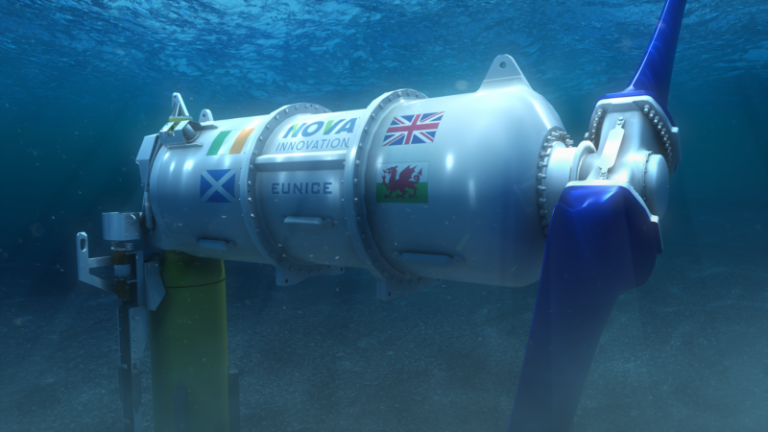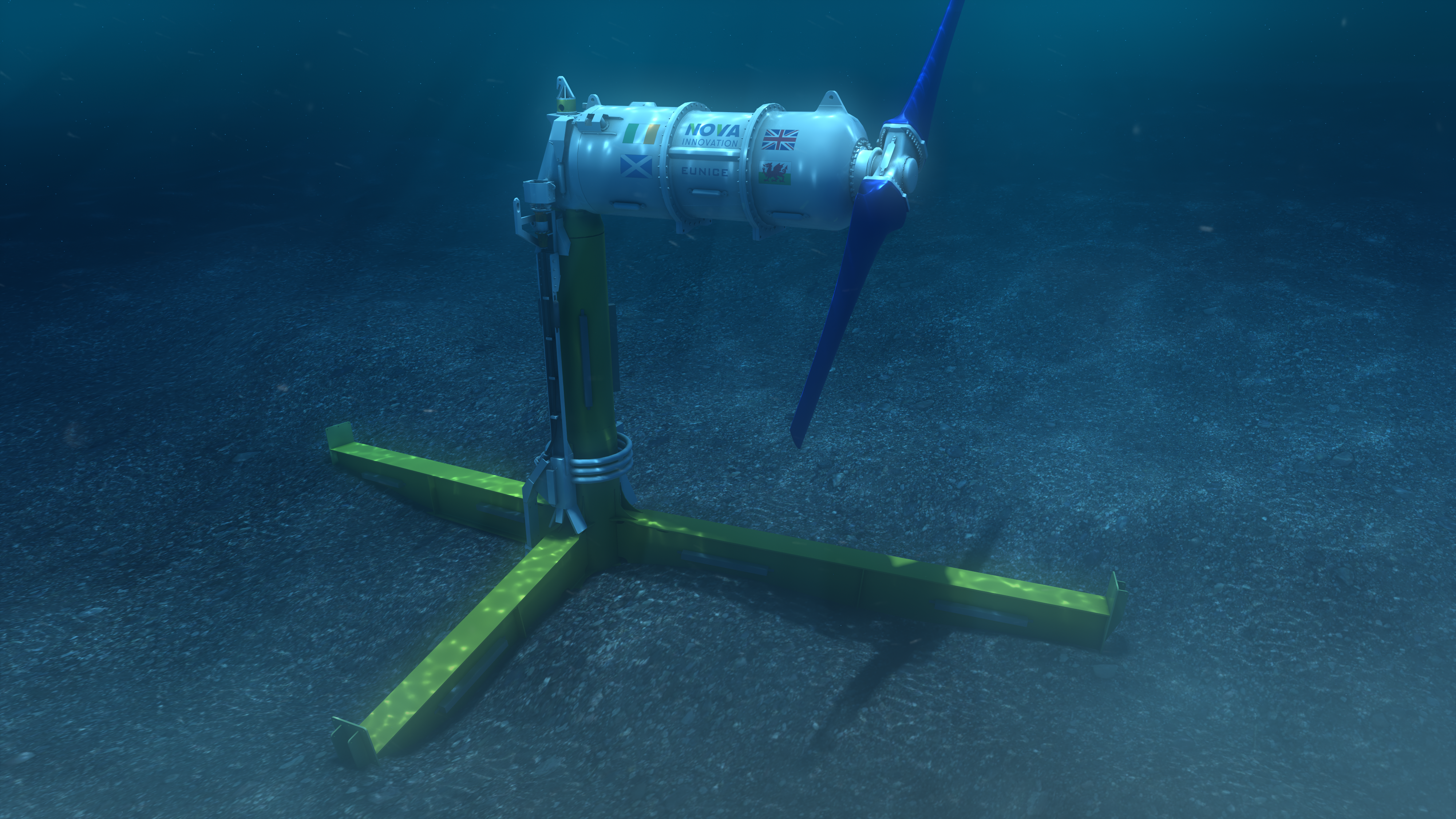What is tidal stream energy?

Tidal stream energy (also referred to as tidal current energy) is a way of harnessing renewable energy from the tides, the regular rise and fall in the ocean’s waters due to gravitational interactions between the sun, Earth and moon. Tidal stream energy works by capturing kinetic energy from fast-flowing water driven by tidal currents. This is most effective in areas where tidal currents are intensified by topographical features including headlands, inlets and straits, or other places where the shape of the seabed forces water through narrow channels.
Tidal stream devices come in various designs, but concepts featuring turbines on a horizontal axis are particularly common. These are similar to wind turbines (see Figure 1), but they extract energy from moving water rather than air and tend to be smaller in size and capacity (around 1–2 megawatts [MW] versus 8–12 MW for an offshore wind turbine). Similar to wind farms, multiple tidal stream turbines can be deployed in the same location to form arrays. These can either be fixed on the seabed or have floating foundations.
Figure 1. Visualisation of a tidal stream turbine

Source: Nova Innovation
How is tidal stream energy different to tidal range?
Despite harnessing energy from the same natural resource, tidal stream and tidal range are fundamentally different technologies. While tidal stream energy converts the kinetic energy from tidal currents into useable energy, tidal range technologies harvest the potential energy created by the difference in water levels between high and low tide. This requires a basin that can hold large volumes of water, which can be created by building a barrage equipped with turbines and gates across an estuary or bay, or by forming a tidal lagoon.
How can tidal stream energy help reduce carbon emissions?
Tidal stream energy has various qualities that mean including it in the energy mix (i.e. the relative contribution of different sources to energy consumed in a particular place) can effectively complement other variable sources of renewable energy and thus contribute to efforts to reduce emissions and improve the overall resilience of the energy system. First, it does not directly emit any carbon dioxide (CO2). Also, the times at which energy generation from tidal stream is available is not affected by the same sources of variation (i.e. the weather and solar radiation) that affect the supply of wind and solar energy, so it can complement these sources. Furthermore, unlike wind and solar, tidal stream generation is highly predictable far into the future.
Tidal stream generation is currently more expensive than more mature renewables. For example, in the fourth allocation round (2021/22) of the UK’s Contracts for Difference (CfD) auctions (the key mechanism for supporting low-carbon electricity generation in the UK), projects featuring solar photovoltaic power secured contracts at a price of around £46/megawatt hours (MWh) and offshore wind at £37/MWh, whereas tidal stream stood at £179/MWh. However, tidal stream energy offers certain benefits for the energy system that solar and wind generation cannot (namely predictability, as previously discussed) and it is estimated that the levelised cost of energy from tidal stream could fall to £78/MWh by 2035. Cost reductions are expected to come from economies of scale, economies of volume from larger farms and accelerated learning: the same drivers that have already led to dramatic cost reductions in renewable technologies including offshore wind. In this way, tidal stream energy could be part of a cost-effective decarbonisation pathway.
Current status of tidal stream energy around the world
Tidal stream energy is in its infancy globally. This is primarily due to high technology costs, limited access to support through government subsidies, uncertainty over its environmental impacts, and limited evidence of the technology’s ability to operate for sustained periods of time without the need for maintenance – although there are some examples of sustained operation, including the MeyGen project off the north coast of Scotland and Nova Innovation’s Shetland Tidal Array.
Only a few countries are currently active in the tidal stream energy landscape. The UK is at the forefront of tidal stream development in terms of its active installed capacity, capacity under development and the number of tidal stream technology developers based in the country. The UK is rivalled only by France and Canada in terms of tidal stream capacity under development, and by the US in terms of number of tidal stream technology developers. However, even the UK’s leading position represents a relatively small-scale sectoral development. The 10 MW of tidal stream capacity currently installed in the UK is less than 0.1% of the estimated practical tidal stream resource of the UK and Channel Islands (i.e. 11.5 gigawatts [GW] or around 11% of the UK’s current annual electricity demand).
Future outlook of the global market for tidal stream energy
The size of the future global market for tidal stream energy will be dictated to a large extent by the natural resource that can feasibly be exploited. Despite some differences in estimates, there is reasonable agreement that the global tidal stream energy resource is equivalent to more than 100 GW of generating capacity. This kind of number is significant, especially when accounting for the potential to use tidal stream energy in locations such as remove islands where alternative sources may be lacking, but smaller than equivalent estimates for some of the more established renewables: offshore wind is estimated to have over 71,000 GW of technically extractable power potential.
The tidal stream energy generation that will realistically be deployed in the short term is expected to be a small fraction of the total estimated resource. For example, a scenario produced by Ocean Energy Europe that represents a ‘high growth’ scenario for ocean energy sees only about 2.4 GW of tidal stream capacity deployed globally by 2030. But, looking further ahead, the global tradeable market from tidal stream energy is estimated to be worth almost £13 billion annually by 2050, assuming 50 GW of capacity is deployed globally by that year.
Tidal stream energy policy in the UK
Tidal stream technologies have initially struggled to secure revenue support through the CfD scheme as they had to compete against more established technologies. This meant that, until recently, tidal stream deployment was limited to single turbine demonstration projects.
The UK’s 2019 commitment to achieving net zero emissions by 2050 created an even stronger imperative for the country to achieve a low-carbon, diverse and resilient energy mix with a much greater role for renewables. This has contributed to more favourable perceptions of tidal stream energy in recent years, also supported by the successes of some high-profile technology demonstrations and improved coordination of the sector itself.
Interest in the tidal stream sector grew further in 2021 due to rising global energy prices and heightened concerns around energy security. In that same year, it was announced that tidal stream energy would for the first time receive a ringfenced budget (a minimum set aside for this specific technology) of £20 million per year under the CfD auctions. As a result, four projects with a combined capacity of 40.8 MW secured contracts to come into operation by 2027. In 2023, it was confirmed that the ringfence for tidal stream energy will continue at a sum of £10 million per year in the next round of CfD auctions.
Several key policy documents from the UK Government – including the Net Zero Strategy of 2021 and the British Energy Security Strategy of 2022 – have acknowledged the potential of tidal stream energy. At the start of 2023, the Independent Review of Net Zero highlighted tidal stream energy as an area in which the UK is a ‘first mover’ and, with further investments, could create distinct advantages in the future.
Continued support for the deployment of tidal stream energy coupled with the development of a strong domestic supply chain could unlock important sustainable growth opportunities for the UK.
This Explainer was written by Esin Serin.

